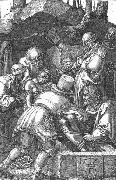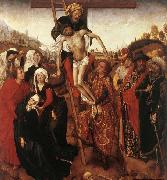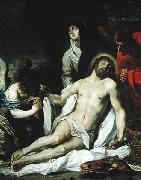Wholesale Oil Painting No Minimum |
|||||||||||
|
|
|||||||||||

|
|||||||||||
|
|
|
||||||||
CorreggioItalian 1489-1534 Correggio Locations Italian painter and draughtsman. Apart from his Venetian contemporaries, he was the most important northern Italian painter of the first half of the 16th century. His best-known works are the illusionistic frescoes in the domes of S Giovanni Evangelista and the cathedral in Parma, where he worked from 1520 to 1530. The combination of technical virtuosity and dramatic excitement in these works ensured their importance for later generations of artists. His altarpieces of the same period are equally original and ally intimacy of feeling with an ecstatic quality that seems to anticipate the Baroque. In his paintings of mythological subjects, especially those executed after his return to Correggio around 1530, he created images whose sensuality and abandon have been seen as foreshadowing the Rococo. Vasari wrote that Correggio was timid and virtuous, that family responsibilities made him miserly and that he died from a fever after walking in the sun. He left no letters and, apart from Vasari account, nothing is known of his character or personality beyond what can be deduced from his works. The story that he owned a manuscript of Bonaventura Berlinghieri Geographia, as well as his use of a latinized form of Allegri (Laetus), and his naming of his son after the humanist Pomponius Laetus, all suggest that he was an educated man by the standards of painters in this period. The intelligence of his paintings supports this claim. Relatively unknown in his lifetime, Correggio was to have an enormous posthumous reputation. He was revered by Federico Barocci and the Carracci, and throughout the 17th and 18th centuries his reputation rivalled that of Raphael. |
||||||||
|
|
||||||||
Deposition
Deposition Painting ID:: 522 |
Galleria Nazionale, Parma Galleria Nazionale, Parma |
|||||||
|
|
||||||||
WEYDEN, Rogier van derNetherlandish Northern Renaissance Painter, ca.1400-1464 major early Flemish master, known also as Roger de la Pasture. He is believed to have studied with Robert Campin. His early works also show the influence of Jan van Eyck. Van Eyck, however, had been a master at objective rendering of detail, whereas Roger in his work portrayed emotions with an assurance that has not been surpassed. His ability to depict piety is reflected in the early masterpiece Descent from the Cross (c.1435; Prado); he depicted with significant restraint the profound grief of the mourners grouped around the tragic figure of Jesus. His composition strongly affected later representations of the theme. Roger became City Painter in Brussels in 1436. He then produced a series of undated altarpieces including the Last Judgment (hospital, Beaune), the Braque Triptych (Louvre), Crucifixion with Donors (Vienna), and Adoration of the Magi (Berlin), which vary in execution from a stress on sumptuous details to a more sculptural rendering of the figures. Roger is believed to have made a pilgrimage to Italy in the holy year 1450. Whether this supposed excursion had any effect on his style is much debated. It has been shown that his Entombment (Uffizi) bears an affinity to the Tuscan treatment of the subject, particularly by Fra Angelico, and that Roger's Virgin and Child with Saints (Frankfurt) has a strong resemblance to the Italian religious art of the day. His style is, however, highly individual. His religious paintings and his portraits are characterized by a straightforward monumentality. The portraits, such as that of a young lady (National Gall. of Art, Washington, D.C.) and of Francesco d'Este (Metropolitan Mus.) exhibit a simple clarity of contour and psychological penetration. Other notable works are his St. Luke Painting the Virgin, of which a version or replica is in the Museum of Fine Arts, Boston, the Crucifixion |
||||||||
|
|
||||||||
|
|
Deposition
Deposition Painting ID:: 7245 |
c. 1435
Oil on oak panel, 220 x 262 cm
Museo del Prado, Madrid c. 1435 Oil on oak panel, 220 x 262 cm Museo del Prado, Madrid |
||||||
|
|
||||||||
Roger Van Der Weydenc.1399-1464 Rogier van der Weyden was the son of Henri de le Pasture, a cutler in Tournai, and Agn?s de Watreloz. His birthdate is estimated from the facts that he was stated to be 35 in April 1435 and 43 in September 1441. Before or in 1427 he married Elisabeth Goffaert (c. 1405-77), whose father was a prosperous shoemaker in Brussels. Rogier may have lived for a time in Brussels: his eldest child Cornelis (b 1427) was sometimes referred to as 'de Bruxella' but was not necessarily a native of Brussels. On 5 March 1427 'Rogelet de le Pasture, natif de Tournai' was apprenticed to the Tournai painter Robert Campin. This Rogelet duly completed his apprenticeship in 1431 and on 1 August 1432 became a master of the Tournai guild. Despite much debate, it would appear that Rogelet was Rogier van der Weyden, though it has also been argued that in 1427 Rogier was a married man well past the normal age of apprenticeship and that Rogelet must have been a second Tournai painter of the same name. JACQUES DARET, however, was in his twenties when in 1428 he was apprenticed to Campin, and other instances can be cited of married apprentices. The political situation at Tournai in 1427-8 was unusual, and the guild system was not functioning normally. |
||||||||
|
|
||||||||
|
|
Deposition
Deposition Painting ID:: 30410 |
mk68
Oil on oak
Madird
mk68 Oil on oak Madird |
||||||
|
|
||||||||
Jacopo PontormoItalian 1494-1557 Jacopo Pontormo Galleries Italian painter and draughtsman. He was the leading painter in mid-16th-century Florence and one of the most original and extraordinary of Mannerist artists. His eccentric personality, solitary and slow working habits and capricious attitude towards his patrons are described by Vasari; his own diary, which covers the years 1554-6, further reveals a character with neurotic and secretive aspects. Pontormo enjoyed the protection of the Medici family throughout his career but, unlike Agnolo Bronzino and Giorgio Vasari, did not become court painter. His subjective portrait style did not lend itself to the state portrait. He produced few mythological works and after 1540 devoted himself almost exclusively to religious subjects. His drawings, mainly figure studies in red and black chalk, are among the highest expressions of the great Florentine tradition of draughtsmanship; close to 400 survive, forming arguably the most important body of drawings by a Mannerist painter. His highly personal style was much influenced by Michelangelo, though he also drew on northern art, primarily the prints of Albrecht Derer. |
||||||||
|
|
||||||||
|
|
Deposition
Deposition Painting ID:: 30485 |
mk68
Oil on wood
Florence
Church of Santa Felicita
c.1528
Italy
mk68 Oil on wood Florence Church of Santa Felicita c.1528 Italy |
||||||
|
|
||||||||
CorreggioItalian 1489-1534 Correggio Locations Italian painter and draughtsman. Apart from his Venetian contemporaries, he was the most important northern Italian painter of the first half of the 16th century. His best-known works are the illusionistic frescoes in the domes of S Giovanni Evangelista and the cathedral in Parma, where he worked from 1520 to 1530. The combination of technical virtuosity and dramatic excitement in these works ensured their importance for later generations of artists. His altarpieces of the same period are equally original and ally intimacy of feeling with an ecstatic quality that seems to anticipate the Baroque. In his paintings of mythological subjects, especially those executed after his return to Correggio around 1530, he created images whose sensuality and abandon have been seen as foreshadowing the Rococo. Vasari wrote that Correggio was timid and virtuous, that family responsibilities made him miserly and that he died from a fever after walking in the sun. He left no letters and, apart from Vasari account, nothing is known of his character or personality beyond what can be deduced from his works. The story that he owned a manuscript of Bonaventura Berlinghieri Geographia, as well as his use of a latinized form of Allegri (Laetus), and his naming of his son after the humanist Pomponius Laetus, all suggest that he was an educated man by the standards of painters in this period. The intelligence of his paintings supports this claim. Relatively unknown in his lifetime, Correggio was to have an enormous posthumous reputation. He was revered by Federico Barocci and the Carracci, and throughout the 17th and 18th centuries his reputation rivalled that of Raphael. |
||||||||
|
|
||||||||
|
|
Deposition
Deposition Painting ID:: 31634 |
mk74
158.5x184.3cm
Parma
Galleria Nazionale
mk74 158.5x184.3cm Parma Galleria Nazionale |
||||||
|
|
||||||||
Machuca, PedroSpanish, approx. 1490-1550 Spanish painter and architect. The form of his signature (Petrus Machuca, Hispanus. Toletanus ...) on his earliest known work, the Virgin of Succour (1517; Madrid, Prado), suggests he was active at an early age in Italy. On the basis of the style of that work, a number of frescoes in the Vatican have been attributed to him, including Isaiah Blessing Jacob. Other works from the same period that have been attributed to him include a copy (Paris, Louvre) of the destroyed Battle of Anghiari by Leonardo da Vinci and two paintings of the Virgin and Child |
||||||||
|
|
||||||||
|
|
Deposition
Deposition Painting ID:: 32865 |
mk84
1520-25
Madrid
mk84 1520-25 Madrid |
||||||
|
|
||||||||
Pontormo, Jacopob Pontormo, nr Empoli, 26 May 1494; d Florence, 31 Dec 1556). Italian painter and draughtsman. He was the leading painter in mid-16th-century Florence and one of the most original and extraordinary of Mannerist artists. His eccentric personality, solitary and slow working habits and capricious attitude towards his patrons are described by Vasari; his own diary, which covers the years 1554-6, further reveals a character with neurotic and secretive aspects. Pontormo enjoyed the protection of the Medici family throughout his career but, unlike Agnolo Bronzino and Giorgio Vasari, did not become court painter. His subjective portrait style did not lend itself to the state portrait. He produced few mythological works and after 1540 devoted himself almost exclusively to religious subjects. His drawings, mainly figure studies in red and black chalk, are among the highest expressions of the great Florentine tradition of draughtsmanship; close to 400 survive, forming arguably the most important body of drawings by a Mannerist painter. His highly personal style was much influenced by Michelangelo |
||||||||
|
|
||||||||
|
|
Deposition
Deposition Painting ID:: 33254 |
mk83
c.1525
mk83 c.1525 |
||||||
|
|
||||||||
Fra AngelicoFra Angelico Galleries b.c. 1400, Vicchio, Florence d.Feb. 18, 1455, Rome Fra Angelico (c. 1395 ?C February 18, 1455), born Guido di Pietro, was an Early Italian Renaissance painter, referred to in Vasari's Lives of the Artists as having "a rare and perfect talent". Known in Italy as il Beato Angelico, he was known to his contemporaries as Fra Giovanni da Fiesole (Brother John from Fiesole). In Giorgio Vasari's Lives of the Artists, written prior to 1555, he was already known as Fra Giovanni Angelico (Brother Giovanni the Angelic One). Within his lifetime or shortly thereafter he was also called Il Beato (the Blessed), in reference to his skills in painting religious subjects. In 1982 Pope John Paul II conferred beatification, thereby making this title official. Fiesole is sometimes misinterpreted as being part of his formal name, but it was merely the name of the town where he took his vows, used by contemporaries to separate him from other Fra Giovannis. He is listed in the Roman Martyrology as Beatus Ioannes Faesulanus, cognomento Angelicus??"Blessed Giovanni of Fiesole, nicknamed Angelico". Fra Angelico was working at a time when the style of painting was in a state of change. This process of change had begun a hundred years previous with the works of Giotto and several of his contemporaries, notably Giusto de' Menabuoi, both of whom had created their major works in Padua, although Giotto was trained in Florence by the great Gothic artist, Cimabue, and painted a fresco cycle of St Francis in the Bardi Chapel in Santa Croce. Giotto had many enthusiastic followers, who imitated his style in fresco, some of them, notably the Lorenzetti, achieving great success. |
||||||||
|
|
||||||||
|
|
Deposition
Deposition Painting ID:: 33258 |
mk83
c.1430-1440
mk83 c.1430-1440 |
||||||
|
|
||||||||
Rosso FiorentinoItalian Mannerist Painter, ca.1495-1540 Born in Florence Italy with the red hair that gave him his nickname, Rosso first trained in the studio of Andrea del Sarto alongside his contemporary, Pontormo. In late 1523, Rosso moved to Rome, where he was exposed to the works of Michelangelo, Raphael, and other Renaissance artists, resulting in the realignment of his artistic style. Fleeing Rome after the Sacking of 1527, Rosso eventually went to France where he secured a position at the court of Francis I in 1530, remaining there until his death. Together with Francesco Primaticcio, Rosso was one of the leading artists to work at the Chateau Fontainebleau as part of the "First School of Fontainebleau", spending much of his life there. Following his death in 1540 (which, according to an unsubstantiated claim by Vasari, was a suicide ), Francesco Primaticcio took charge of the artistic direction at Fontainebleau. Rosso's reputation, along those of other stylized late Renaissance Florentines, was long out of favour in comparison to other more naturalistic and graceful contemporaries, but has revived considerably in recent decades. That his masterpiece is in a small city, away from the tourist track, was a factor in this, especially before the arrival of photography. His poses are certainly contorted, and his figures often appear haggard and thin, but his work has considerable power. |
||||||||
|
|
||||||||
|
|
Deposition
Deposition Painting ID:: 33291 |
mk83
1521
mk83 1521 |
||||||
|
|
||||||||
Rosso FiorentinoItalian Mannerist Painter, ca.1495-1540 Born in Florence Italy with the red hair that gave him his nickname, Rosso first trained in the studio of Andrea del Sarto alongside his contemporary, Pontormo. In late 1523, Rosso moved to Rome, where he was exposed to the works of Michelangelo, Raphael, and other Renaissance artists, resulting in the realignment of his artistic style. Fleeing Rome after the Sacking of 1527, Rosso eventually went to France where he secured a position at the court of Francis I in 1530, remaining there until his death. Together with Francesco Primaticcio, Rosso was one of the leading artists to work at the Chateau Fontainebleau as part of the "First School of Fontainebleau", spending much of his life there. Following his death in 1540 (which, according to an unsubstantiated claim by Vasari, was a suicide ), Francesco Primaticcio took charge of the artistic direction at Fontainebleau. Rosso's reputation, along those of other stylized late Renaissance Florentines, was long out of favour in comparison to other more naturalistic and graceful contemporaries, but has revived considerably in recent decades. That his masterpiece is in a small city, away from the tourist track, was a factor in this, especially before the arrival of photography. His poses are certainly contorted, and his figures often appear haggard and thin, but his work has considerable power. |
||||||||
|
|
||||||||
|
|
Deposition
Deposition Painting ID:: 33499 |
mk86
1521
Oil on wood
333x195cm
Volterra Pinacoteca Comunale
mk86 1521 Oil on wood 333x195cm Volterra Pinacoteca Comunale |
||||||
|
|
||||||||
PontormoItalian Mannerist Painter, 1494-ca.1556 Italian painter and draughtsman. He was the leading painter in mid-16th-century Florence and one of the most original and extraordinary of Mannerist artists. His eccentric personality, solitary and slow working habits and capricious attitude towards his patrons are described by Vasari; his own diary, which covers the years 1554-6, further reveals a character with neurotic and secretive aspects. Pontormo enjoyed the protection of the Medici family throughout his career but, unlike Agnolo Bronzino and Giorgio Vasari, did not become court painter. His subjective portrait style did not lend itself to the state portrait. He produced few mythological works and after 1540 devoted himself almost exclusively to religious subjects. His drawings, mainly figure studies in red and black chalk, are among the highest expressions of the great Florentine tradition of draughtsmanship; close to 400 survive, forming arguably the most important body of drawings by a Mannerist painter. |
||||||||
|
|
||||||||
|
|
Deposition
Deposition Painting ID:: 33500 |
mk86
c.1526-1528
Oil on wood
313x192cm
Florence,Santa Felicita,Cappella Bardori
mk86 c.1526-1528 Oil on wood 313x192cm Florence,Santa Felicita,Cappella Bardori |
||||||
|
|
||||||||
Rogier van der WeydenRogier van der Weyden 1399/1400 - 1464 was the most important representative of Netherlandish painting or Northern Renaissance ... is, with Jan van Eyck, considered one of the greatest exponents of the school of Early Netherlandish painting. Rogier van der Weyden was born in Tournai as 'Rogier de le Pasture' (Roger of the Pasture) in 1399 or 1400. His parents were Henri de le Pasture and Agnes de Watr??los. The family had settled before in the city of Tournai where Rogiers father worked as a 'maître-coutelier' (knife manufacturer). In 1426 Rogier married Elisabeth, the daughter of the Brussels shoemaker Jan Goffaert and his wife Cathelyne van Stockem. Rogier and Elisabeth had four children: Cornelius, who became a Carthusian monk, was born in 1427, a daughter Margaretha in 1432. Before 21 October 1435 the family settled in Brussels where the two younger children were born: Pieter in 1437 and Jan the next year. From the second of March 1436 onwards held the title of 'painter to the town of Brussels' (stadsschilder) a very prestigious post because Brussels was at that time the most important residence of the splendid court of the Dukes of Burgundy. It was at the occasion of his move to the Dutch-speaking town of Brussels that Rogier began using the Dutch version of his name: 'Rogier van der Weyden'Little is known about Rogier's training as a painter. The archival sources from Tournai (completely destroyed during World War II, but luckily partly transcribed in the 19th and early 20th century) are somewhat confusing and have led to different interpretations by scholars. From a document it is known that the city council of Tournai offered wine in honour of a certain 'Maistre Rogier de le Pasture' on March the 17th 1427. However, on the 5th of March of the following year the records of the painters' guild show a certain 'Rogelet de le Pasture' entered the workshop of Robert Campin together with Jacques Daret. Only five years later, on the first of August 1432, Rogier de le Pasture obtains the title of 'Master' (Maistre) as a painter.[1] Many have doubted whether Campin's apprentice 'Rogelet' was the same as the master 'Rogier' that was offered the wine back in 1426. The fact that in 1426-1427 Rogier was a married man in his late twenties, and well over the normal age of apprenticeship has been used as an argument to consider 'Rogelet' as a younger painter with the same name. In the 1420's however the city of Tournai was in crisis and as a result the guilds were not functioning normally. The late apprenticeship of Rogier/Rogelet may have been a legal formality. Also Jacques Daret was then in his twenties and had been living and working in Campin's household for at least a decade. It is possible that Rogier obtained an academic title (Master) before he became a painter and that he was awarded the wine of honour on the occasion of his graduation. The sophisticated and 'learned' iconographical and compositional qualities of the paintings attributed to him are sometimes used as an argument in favour of this supposition. The social and intellectual status of Rogier in his later life surpassed that of a mere craftsman at that time. In general the close stylistical link between the documented works of Jacques Daret, and the paintings attributed to Robert Campin and Rogier van der Weyden is considered as the main argument to consider Rogier van der Weyden as a pupil of Robert Campin. The last mention of Rogier de la Pasture in the financial records of Tournai, on October 21, 1435, lists him as demeurrant ?? Brouxielles ('living in Brussels'). At the same time, the first mention of Rogier de Weyden is made as the official painter of Brussels. Therefore Rogier de la Pasture and Rogier Van der Weyden are thought to be one and the same painter. The post of city painter was created especially for Van der Weyden and was meant to lapse on his death. It was linked to a huge commission to paint four justice scenes for the 'Golden Chamber' of Brussels City Hall.[2] Different properties and investments are documented and witness his material prosperity. The portraits he painted of the Burgundian Dukes, their relatives and courtiers, demonstrate a close relationship with the elite of the Netherlands. The Miraflores Altarpiece was probably commissioned by King Juan II of Castile, since Juan II donated it to the monastery of Miraflores in 1445. |
||||||||
|
|
||||||||
|
|
Deposition
Deposition Painting ID:: 40183 |
mk156
c.1435
Oil on panel
220x262cm
mk156 c.1435 Oil on panel 220x262cm |
||||||
|
|
||||||||
Pontormo, Jacopob Pontormo, nr Empoli, 26 May 1494; d Florence, 31 Dec 1556). Italian painter and draughtsman. He was the leading painter in mid-16th-century Florence and one of the most original and extraordinary of Mannerist artists. His eccentric personality, solitary and slow working habits and capricious attitude towards his patrons are described by Vasari; his own diary, which covers the years 1554-6, further reveals a character with neurotic and secretive aspects. Pontormo enjoyed the protection of the Medici family throughout his career but, unlike Agnolo Bronzino and Giorgio Vasari, did not become court painter. His subjective portrait style did not lend itself to the state portrait. He produced few mythological works and after 1540 devoted himself almost exclusively to religious subjects. His drawings, mainly figure studies in red and black chalk, are among the highest expressions of the great Florentine tradition of draughtsmanship; close to 400 survive, forming arguably the most important body of drawings by a Mannerist painter. His highly personal style was much influenced by Michelangelo |
||||||||
|
|
||||||||
|
|
Deposition
Deposition Painting ID:: 40329 |
mk156
1525-28
Oil on panel
313x192cm
mk156 1525-28 Oil on panel 313x192cm |
||||||
|
|
||||||||
Fra AngelicoFra Angelico Galleries b.c. 1400, Vicchio, Florence d.Feb. 18, 1455, Rome Fra Angelico (c. 1395 ?C February 18, 1455), born Guido di Pietro, was an Early Italian Renaissance painter, referred to in Vasari's Lives of the Artists as having "a rare and perfect talent". Known in Italy as il Beato Angelico, he was known to his contemporaries as Fra Giovanni da Fiesole (Brother John from Fiesole). In Giorgio Vasari's Lives of the Artists, written prior to 1555, he was already known as Fra Giovanni Angelico (Brother Giovanni the Angelic One). Within his lifetime or shortly thereafter he was also called Il Beato (the Blessed), in reference to his skills in painting religious subjects. In 1982 Pope John Paul II conferred beatification, thereby making this title official. Fiesole is sometimes misinterpreted as being part of his formal name, but it was merely the name of the town where he took his vows, used by contemporaries to separate him from other Fra Giovannis. He is listed in the Roman Martyrology as Beatus Ioannes Faesulanus, cognomento Angelicus??"Blessed Giovanni of Fiesole, nicknamed Angelico". Fra Angelico was working at a time when the style of painting was in a state of change. This process of change had begun a hundred years previous with the works of Giotto and several of his contemporaries, notably Giusto de' Menabuoi, both of whom had created their major works in Padua, although Giotto was trained in Florence by the great Gothic artist, Cimabue, and painted a fresco cycle of St Francis in the Bardi Chapel in Santa Croce. Giotto had many enthusiastic followers, who imitated his style in fresco, some of them, notably the Lorenzetti, achieving great success. |
||||||||
|
|
||||||||
|
|
Deposition
Deposition Painting ID:: 52087 |
1437-40
Tempera on wood,
176 x 185 cm 1437-40 Tempera on wood, 176 x 185 cm |
||||||
|
|
||||||||
Rogier van der WeydenRogier van der Weyden 1399/1400 - 1464 was the most important representative of Netherlandish painting or Northern Renaissance ... is, with Jan van Eyck, considered one of the greatest exponents of the school of Early Netherlandish painting. Rogier van der Weyden was born in Tournai as 'Rogier de le Pasture' (Roger of the Pasture) in 1399 or 1400. His parents were Henri de le Pasture and Agnes de Watr??los. The family had settled before in the city of Tournai where Rogiers father worked as a 'maître-coutelier' (knife manufacturer). In 1426 Rogier married Elisabeth, the daughter of the Brussels shoemaker Jan Goffaert and his wife Cathelyne van Stockem. Rogier and Elisabeth had four children: Cornelius, who became a Carthusian monk, was born in 1427, a daughter Margaretha in 1432. Before 21 October 1435 the family settled in Brussels where the two younger children were born: Pieter in 1437 and Jan the next year. From the second of March 1436 onwards held the title of 'painter to the town of Brussels' (stadsschilder) a very prestigious post because Brussels was at that time the most important residence of the splendid court of the Dukes of Burgundy. It was at the occasion of his move to the Dutch-speaking town of Brussels that Rogier began using the Dutch version of his name: 'Rogier van der Weyden'Little is known about Rogier's training as a painter. The archival sources from Tournai (completely destroyed during World War II, but luckily partly transcribed in the 19th and early 20th century) are somewhat confusing and have led to different interpretations by scholars. From a document it is known that the city council of Tournai offered wine in honour of a certain 'Maistre Rogier de le Pasture' on March the 17th 1427. However, on the 5th of March of the following year the records of the painters' guild show a certain 'Rogelet de le Pasture' entered the workshop of Robert Campin together with Jacques Daret. Only five years later, on the first of August 1432, Rogier de le Pasture obtains the title of 'Master' (Maistre) as a painter.[1] Many have doubted whether Campin's apprentice 'Rogelet' was the same as the master 'Rogier' that was offered the wine back in 1426. The fact that in 1426-1427 Rogier was a married man in his late twenties, and well over the normal age of apprenticeship has been used as an argument to consider 'Rogelet' as a younger painter with the same name. In the 1420's however the city of Tournai was in crisis and as a result the guilds were not functioning normally. The late apprenticeship of Rogier/Rogelet may have been a legal formality. Also Jacques Daret was then in his twenties and had been living and working in Campin's household for at least a decade. It is possible that Rogier obtained an academic title (Master) before he became a painter and that he was awarded the wine of honour on the occasion of his graduation. The sophisticated and 'learned' iconographical and compositional qualities of the paintings attributed to him are sometimes used as an argument in favour of this supposition. The social and intellectual status of Rogier in his later life surpassed that of a mere craftsman at that time. In general the close stylistical link between the documented works of Jacques Daret, and the paintings attributed to Robert Campin and Rogier van der Weyden is considered as the main argument to consider Rogier van der Weyden as a pupil of Robert Campin. The last mention of Rogier de la Pasture in the financial records of Tournai, on October 21, 1435, lists him as demeurrant ?? Brouxielles ('living in Brussels'). At the same time, the first mention of Rogier de Weyden is made as the official painter of Brussels. Therefore Rogier de la Pasture and Rogier Van der Weyden are thought to be one and the same painter. The post of city painter was created especially for Van der Weyden and was meant to lapse on his death. It was linked to a huge commission to paint four justice scenes for the 'Golden Chamber' of Brussels City Hall.[2] Different properties and investments are documented and witness his material prosperity. The portraits he painted of the Burgundian Dukes, their relatives and courtiers, demonstrate a close relationship with the elite of the Netherlands. The Miraflores Altarpiece was probably commissioned by King Juan II of Castile, since Juan II donated it to the monastery of Miraflores in 1445. |
||||||||
|
|
||||||||
|
|
Deposition
Deposition Painting ID:: 55936 |
1435-40,oil on oak panel,86.5x102.125 in,220x262 cm,museo del prado,madrid,spain 1435-40,oil on oak panel,86.5x102.125 in,220x262 cm,museo del prado,madrid,spain |
||||||
|
|
||||||||
Gerard Davidb.c. 1460, Oudewater, Neth. d.Aug. 13, 1523, Bruges Flemish Gerard David Locations Netherlandish painter. He is known as the last of the Flemish Primitives. Although born in the northern Netherlands, he moved to Bruges as a young man, and most of his work expresses the impassive, unmannered, microscopically realistic approach peculiar to south Netherlandish art in the time of Jan van Eyck. David was skilled at synthesizing the art of several important south Netherlandish predecessors, adapting, for instance, the compositions of van Eyck and the technique of Hugo van der Goes. He was also influenced by Hans Memling, whose example led him to refine and polish his cruder northern Netherlandish style and to adopt the popular theme of the Virgin and Child enthroned. |
||||||||
|
|
||||||||
|
|
Deposition
Deposition Painting ID:: 58531 |
Deposition
Deposition |
||||||
|
|
||||||||
GOSSAERT, Jan (Mabuse)Flemish Northern Renaissance Painter, ca.1478-1532 |
||||||||
|
|
||||||||
|
|
Deposition
Deposition Painting ID:: 63100 |
1510-20 Oil on canvas transferred from wood, 141 x 106,5 cm The Hermitage, St. Petersburg The picture shows an early example of the works of Romanist painters (Northern artists influenced by Italian renaissance painting). Artist: GOSSAERT, Jan (Mabuse) Painting Title: Deposition , 1501-1550 Painting Style: Flemish , , religious 1510-20 Oil on canvas transferred from wood, 141 x 106,5 cm The Hermitage, St. Petersburg The picture shows an early example of the works of Romanist painters (Northern artists influenced by Italian renaissance painting). Artist: GOSSAERT, Jan (Mabuse) Painting Title: Deposition , 1501-1550 Painting Style: Flemish , , religious |
||||||
|
|
||||||||
Albrecht Durerb.May 21, 1471, Imperial Free City of Nernberg [Germany] d.April 6, 1528, Nernberg Albrecht Durer (May 21, 1471 ?C April 6, 1528) was a German painter, printmaker and theorist from Nuremberg. His still-famous works include the Apocalypse woodcuts, Knight, Death, and the Devil (1513), Saint Jerome in his Study (1514) and Melencolia I (1514), which has been the subject of extensive analysis and interpretation. His watercolours mark him as one of the first European landscape artists, while his ambitious woodcuts revolutionized the potential of that medium. D??rer introduction of classical motifs into Northern art, through his knowledge of Italian artists and German humanists, have secured his reputation as one of the most important figures of the Northern Renaissance. This is reinforced by his theoretical treatise which involve principles of mathematics, perspective and ideal proportions. His prints established his reputation across Europe when he was still in his twenties, and he has been conventionally regarded as the greatest artist of the Renaissance in Northern Europe ever since. |
||||||||
|
|
||||||||
|
|
Deposition
Deposition Painting ID:: 63632 |
1512 Engraving, 117 x 74 mm Metropolitan Museum of Art, New York Sheet No. 13 of the Engraved Passion. In this case the engraved and woodcut version can be easily compared. Both were executed at about the same time. One is the most complicated, the other the simplest solution. In the engraving some of the dignity is sacrificed by the complicated overlappings, as in the case of Christ's body. The woodcut version of the Small Passion was difficult to surpass in the engraving. D?rer decided to use the tomb as seen from the front, making for the interesting overlappings. The gentle dignity of the woodcut version was, however, lost. It is not quite clear which one of the praying women is the Virgin Mary.Artist:D?RER, Albrecht Title: Deposition (No. 13) Painted in 1501-1550 , German - - graphics : religious 1512 Engraving, 117 x 74 mm Metropolitan Museum of Art, New York Sheet No. 13 of the Engraved Passion. In this case the engraved and woodcut version can be easily compared. Both were executed at about the same time. One is the most complicated, the other the simplest solution. In the engraving some of the dignity is sacrificed by the complicated overlappings, as in the case of Christ's body. The woodcut version of the Small Passion was difficult to surpass in the engraving. D?rer decided to use the tomb as seen from the front, making for the interesting overlappings. The gentle dignity of the woodcut version was, however, lost. It is not quite clear which one of the praying women is the Virgin Mary.Artist:D?RER, Albrecht Title: Deposition (No. 13) Painted in 1501-1550 , German - - graphics : religious |
||||||
|
|
||||||||
|
|
||||||||
|
|
Deposition
Deposition Painting ID:: 63942 |
1460 Oil on oak panel, 57 x 52 cm Alte Pinakothek, Munich With the body of Christ still on the Cross high above the scene, this picture, presumably painted in Brussels, shows the Deposition in a more traditional way than Rogier's famous version (Prado, Madrid). On the right are the centurion who recognized the Son of God, and his followers; it is not clear which of the two figures in the foreground is actually the centurion, since they are both making gestures that would be suitable for him. The artist who painted this small Deposition used figures from Rogier van der Weyden's great painting for the body of Christ and for Nicodemus, and drawing on other works by Rogier van der Weyden and by the Master of Flemalle for the remaining figures. The group of the Virgin and St John, for instance, was taken from the Seven Sacraments Altarpiece (Museum of Fine Arts, Antwerp). However, the painter of this Deposition fails to unite the groups of figures successfully. The small panel of the Deposition, certainly not painted before the middle of the century, seems to have found its way quite early to southern Germany, where parts of it were already being copied in 1465 (Hof Altarpiece by Hans Pleydenwurff in the Alte Pinakothek, Munich). Like the composition of the Descent from the Cross, probably of roughly the same date, it is a relatively early example of the work of independent artists who picked up ideas from Rogier, imitating his style as best they could. , Artist: UNKNOWN MASTER, Flemish , Deposition , 1451-1500 , Flemish , painting , religious 1460 Oil on oak panel, 57 x 52 cm Alte Pinakothek, Munich With the body of Christ still on the Cross high above the scene, this picture, presumably painted in Brussels, shows the Deposition in a more traditional way than Rogier's famous version (Prado, Madrid). On the right are the centurion who recognized the Son of God, and his followers; it is not clear which of the two figures in the foreground is actually the centurion, since they are both making gestures that would be suitable for him. The artist who painted this small Deposition used figures from Rogier van der Weyden's great painting for the body of Christ and for Nicodemus, and drawing on other works by Rogier van der Weyden and by the Master of Flemalle for the remaining figures. The group of the Virgin and St John, for instance, was taken from the Seven Sacraments Altarpiece (Museum of Fine Arts, Antwerp). However, the painter of this Deposition fails to unite the groups of figures successfully. The small panel of the Deposition, certainly not painted before the middle of the century, seems to have found its way quite early to southern Germany, where parts of it were already being copied in 1465 (Hof Altarpiece by Hans Pleydenwurff in the Alte Pinakothek, Munich). Like the composition of the Descent from the Cross, probably of roughly the same date, it is a relatively early example of the work of independent artists who picked up ideas from Rogier, imitating his style as best they could. , Artist: UNKNOWN MASTER, Flemish , Deposition , 1451-1500 , Flemish , painting , religious |
||||||
|
|
||||||||
MOLYN, Pieter deEnglish-born Dutch Baroque Era Painter, 1595-1661 Dutch painter, draughtsman and etcher of English birth and Flemish descent. His father, Pieter de Molijn, came from Ghent and his mother, Lynken van den Bossche, from Brussels. It is not known why they went to England, perhaps for employment rather than to avoid religious persecution. Pieter the younger apparently remained proud of his birthplace throughout his life |
||||||||
|
|
||||||||
|
|
Deposition
Deposition Painting ID:: 83671 |
oil on Canvas.
Date XVII
cyf oil on Canvas. Date XVII cyf |
||||||
|
|
||||||||
|
MOLYN, Pieter de English-born Dutch Baroque Era Painter, 1595-1661 Dutch painter, draughtsman and etcher of English birth and Flemish descent. His father, Pieter de Molijn, came from Ghent and his mother, Lynken van den Bossche, from Brussels. It is not known why they went to England, perhaps for employment rather than to avoid religious persecution. Pieter the younger apparently remained proud of his birthplace throughout his life Deposition oil on Canvas. Date XVII cyf |
||||||||
|
|
||||||||
|
Prev Next
|
||||||||
|
|
||||||||
|
Related Paintings to MOLYN, Pieter de :. |
||||||||
|
|
||||||||
|
CONTACT US |
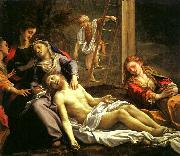

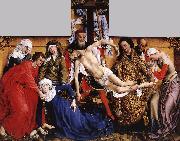
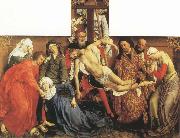
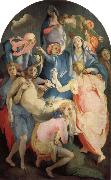
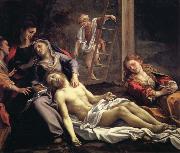
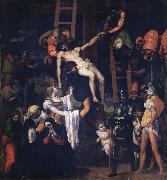

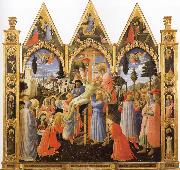
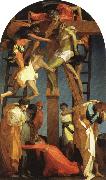
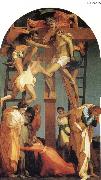
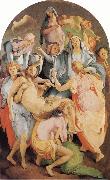
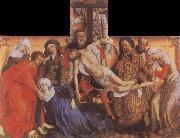
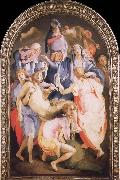
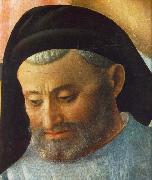
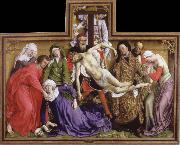
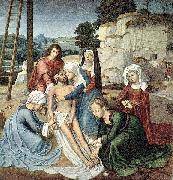
-228282.jpg)
